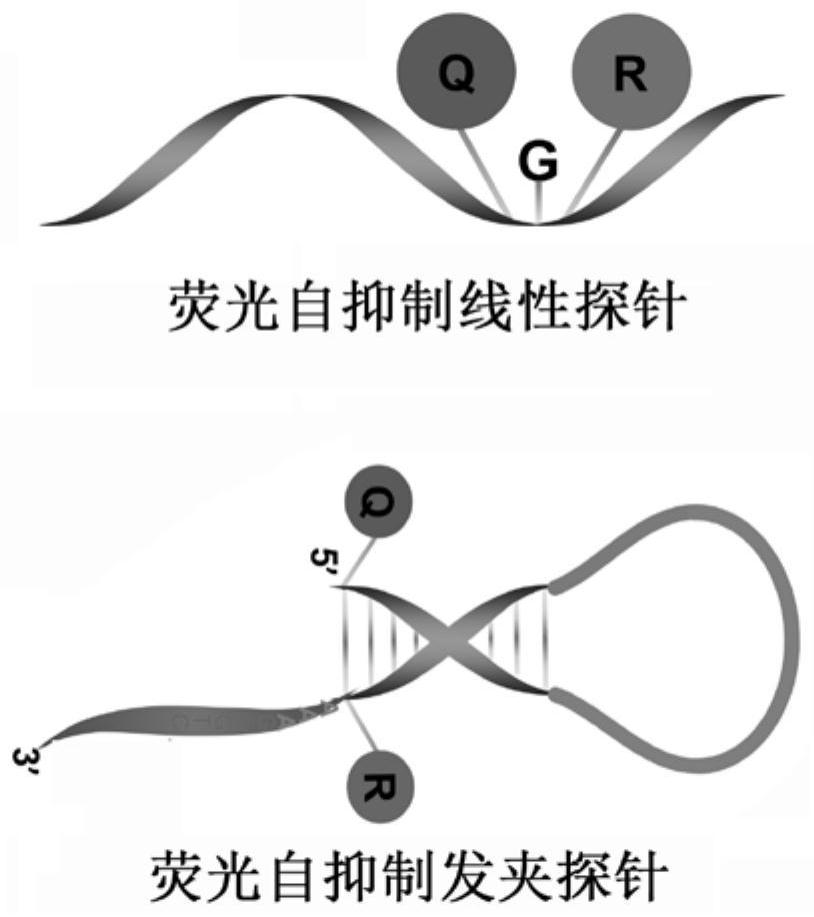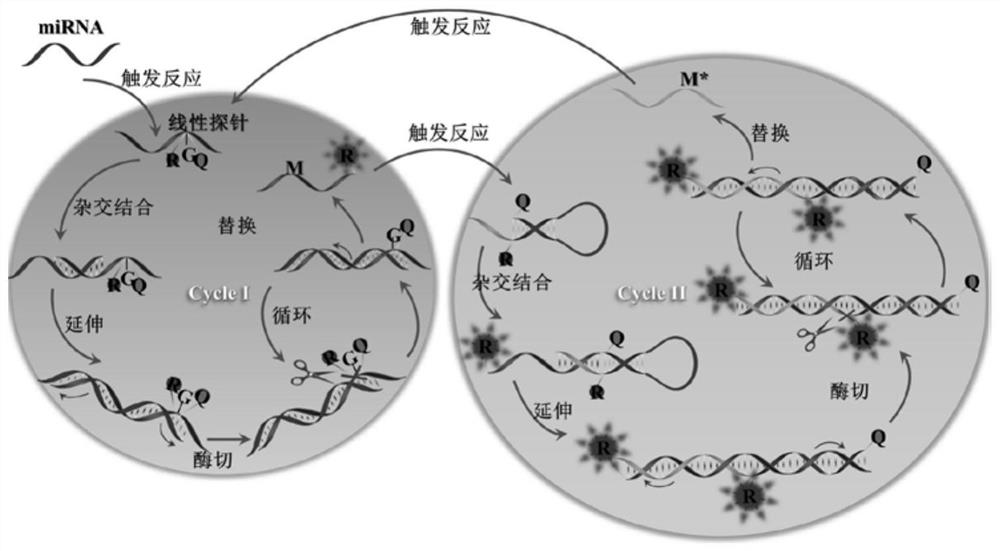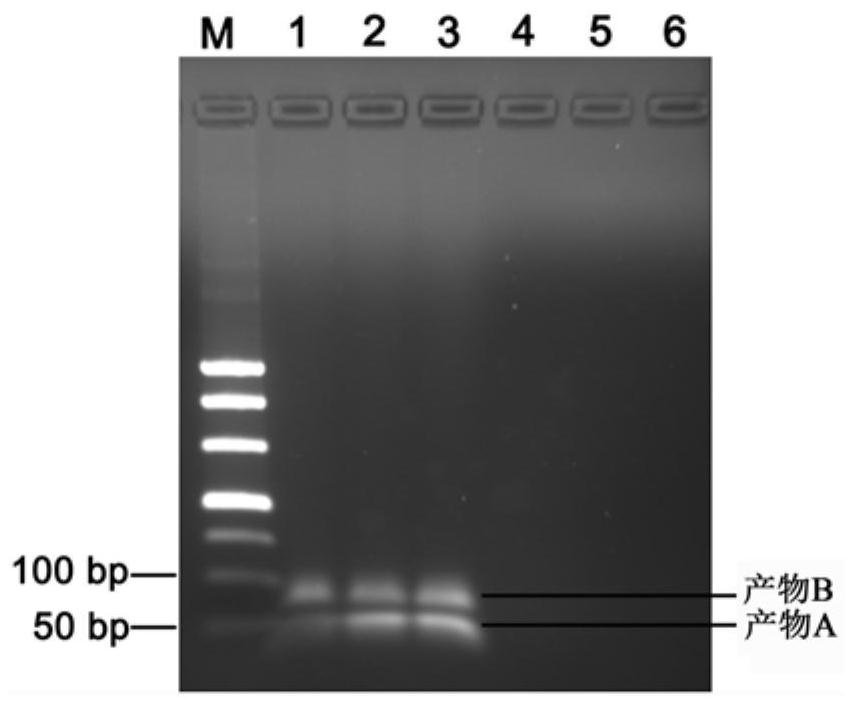Isothermal amplification system and method based on fluorescence self-inhibition probe
An isothermal amplification and self-suppression technology, applied in the field of temperature amplification systems, can solve the problems of reducing fluorescent background signals, low detection efficiency, and poor specificity
- Summary
- Abstract
- Description
- Claims
- Application Information
AI Technical Summary
Problems solved by technology
Method used
Image
Examples
Embodiment 1
[0056] The product specificity analysis of embodiment 1 fluorescent self-inhibiting probe isothermal amplification method
[0057] This example uses the human hsa-miR-223 standard as a sample to provide an isothermal amplification system based on fluorescent self-inhibiting probes for miRNA detection.
[0058] The human hsa-miR-223 sequence was selected as the target sequence (SEQ ID NO.6); for the target sequence, a specific fluorescent self-inhibitory probe was designed, and the probe sequence was: SEQ ID NO.7-8; miR-223 The standard template was added to 20 μL of the isothermal amplification reaction system. The concentrations of the components in the reaction system are: 50mM Tris-HCl (pH 7.9@25°C), 100mM NaCl, 10mM MgCl 2 , 1mM DTT, 0.1U / μL Vent DNA polymerase, 0.2U / μL Nt.BstNBI nicking endonuclease, 0.125mMdNTPs, 0.125μM fluorescent self-inhibiting linear probe, 0.125μM fluorescent self-inhibiting hairpin probe. The isothermal amplification reaction condition is 55°C, ...
Embodiment 2
[0059] The detection sensitivity test of embodiment 2 fluorescent self-inhibiting probe isothermal amplification method
[0060] In this example, several different concentrations of human hsa-miR-223 standards were used as samples to analyze the sensitivity of the isothermal amplification detection method for fluorescent self-inhibiting probes.
[0061] The human hsa-miR-223 sequence was selected as the target sequence, and the hsa-miR-223 standard was diluted tenfold, and the miR-223 templates obtained at different concentrations were added to 20 μL of the isothermal amplification reaction system, and other The components and concentrations were the same as in Example 1, the isothermal amplification reaction lasted 90 minutes, and the fluorescent signal was collected every minute to obtain the following: Figure 4 The real-time fluorescent quantitative amplification curve and standard curve are shown. The results show that the fluorescent self-inhibiting probe isothermal amp...
Embodiment 3
[0062] The detection specificity test of embodiment 3 fluorescent self-inhibiting probe isothermal amplification method
[0063] In this embodiment, the hsa-miR-223 standard product was used as the wild-type control group, and the homologous sequences hsa-miR-223-5p and hsa-miR-599, and the mutant sequences (hsa-miR-223-Mut1, hsa-miR-223-Mut1, hsa-miR-223-Mut2, hsa-miR-223-Mut3) were detected to analyze the detection specificity of the fluorescent self-inhibiting probe isothermal amplification method.
[0064] The hsa-miR-223 sequence was used as the target sequence of the control group; its specific probe sequence was used as the detection probe; the hsa-miR-223 sequence (SEQ ID NO.6), hsa-miR-223- 5p (SEQ ID NO.9), hsa-miR-599 (SEQ ID NO.10), hsa-miR-223-Mut1 (SEQ ID NO.11), hsa-miR-223-Mut2 (SEQ ID NO.12) and the standard substance of hsa-miR-223-Mut3 (SEQ ID NO.13) were added to a 20 μL isothermal amplification reaction system, and the other components and concentrations ...
PUM
 Login to View More
Login to View More Abstract
Description
Claims
Application Information
 Login to View More
Login to View More - R&D
- Intellectual Property
- Life Sciences
- Materials
- Tech Scout
- Unparalleled Data Quality
- Higher Quality Content
- 60% Fewer Hallucinations
Browse by: Latest US Patents, China's latest patents, Technical Efficacy Thesaurus, Application Domain, Technology Topic, Popular Technical Reports.
© 2025 PatSnap. All rights reserved.Legal|Privacy policy|Modern Slavery Act Transparency Statement|Sitemap|About US| Contact US: help@patsnap.com



